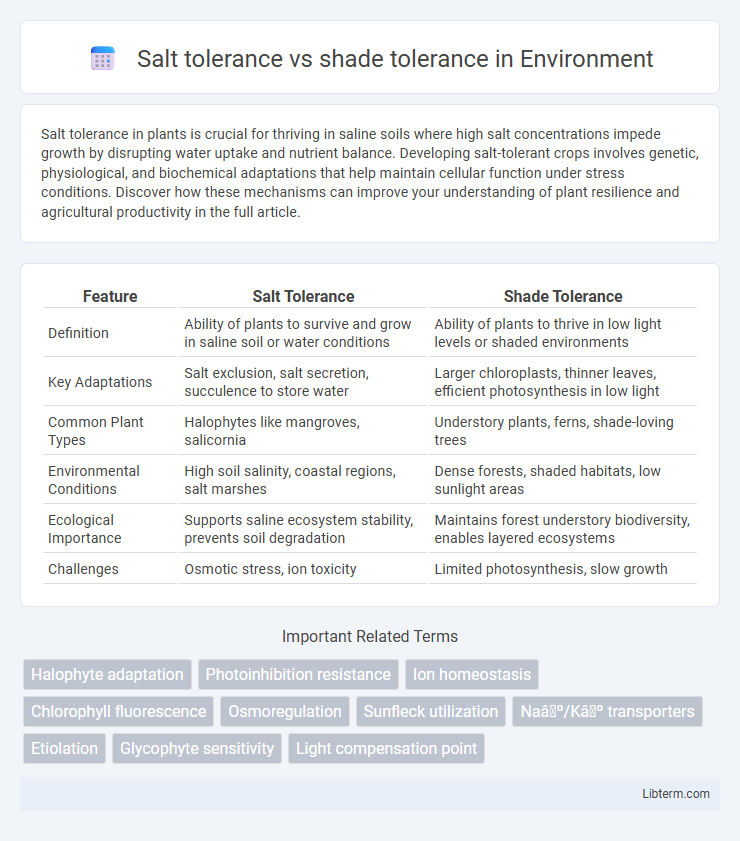Salt tolerance in plants is crucial for thriving in saline soils where high salt concentrations impede growth by disrupting water uptake and nutrient balance. Developing salt-tolerant crops involves genetic, physiological, and biochemical adaptations that help maintain cellular function under stress conditions. Discover how these mechanisms can improve your understanding of plant resilience and agricultural productivity in the full article.
Table of Comparison
| Feature | Salt Tolerance | Shade Tolerance |
|---|---|---|
| Definition | Ability of plants to survive and grow in saline soil or water conditions | Ability of plants to thrive in low light levels or shaded environments |
| Key Adaptations | Salt exclusion, salt secretion, succulence to store water | Larger chloroplasts, thinner leaves, efficient photosynthesis in low light |
| Common Plant Types | Halophytes like mangroves, salicornia | Understory plants, ferns, shade-loving trees |
| Environmental Conditions | High soil salinity, coastal regions, salt marshes | Dense forests, shaded habitats, low sunlight areas |
| Ecological Importance | Supports saline ecosystem stability, prevents soil degradation | Maintains forest understory biodiversity, enables layered ecosystems |
| Challenges | Osmotic stress, ion toxicity | Limited photosynthesis, slow growth |
Introduction to Salt Tolerance and Shade Tolerance
Salt tolerance refers to a plant's ability to survive and thrive in environments with high soil salinity by regulating ion uptake and maintaining cellular homeostasis. Shade tolerance describes a plant's capacity to grow under low light conditions by optimizing photosynthesis efficiency and leaf morphology to capture limited sunlight. Both adaptations involve complex physiological and genetic mechanisms enabling plants to withstand specific environmental stresses.
Defining Salt Tolerance in Plants
Salt tolerance in plants refers to their ability to survive and grow in environments with high concentrations of soluble salts, particularly sodium chloride. This trait involves physiological mechanisms such as ion exclusion, osmotic adjustment, and tissue tolerance that prevent salt-induced damage and maintain cellular function. Salt-tolerant species, often halophytes, actively regulate salt uptake and compartmentalize ions to avoid toxicity and sustain metabolic processes under saline conditions.
Understanding Shade Tolerance Mechanisms
Shade tolerance mechanisms enable plants to optimize photosynthesis under low light by adjusting chlorophyll concentration, leaf anatomy, and light-harvesting complexes. Unlike salt tolerance, which involves ion regulation and osmotic balance, shade tolerance relies on morphological and physiological adaptations such as elongated petioles and larger, thinner leaves to capture limited light efficiently. Understanding these mechanisms enhances selection for species suited to understory environments or urban landscaping with reduced sunlight.
Physiological Adaptations to Salinity
Physiological adaptations to salinity in salt-tolerant plants include ionic regulation, osmotic adjustment, and salt compartmentalization within vacuoles to prevent cellular damage. These plants synthesize compatible solutes like proline and glycine betaine to maintain cell turgor under high salt stress. Salt-exclusion mechanisms in roots and selective ion transporters reduce sodium uptake, enhancing overall salt tolerance compared to shade-tolerant species that primarily adapt to low light conditions.
Key Traits of Shade-Tolerant Species
Shade-tolerant species exhibit key traits such as broad, thin leaves with high chlorophyll content to maximize light absorption in low-light environments and a slow growth rate that conserves energy. These plants typically have a high chlorophyll a/b ratio and efficient photosynthetic mechanisms adapted to shaded habitats. Their root systems are often shallow but extensive, enabling optimal nutrient uptake in competitive understory soils.
Genetic Basis of Salt and Shade Tolerance
Salt tolerance and shade tolerance in plants are regulated by distinct genetic pathways involving specific gene families such as SOS (Salt Overly Sensitive) genes for salt stress and PHY (phytochrome) genes for light perception in shade conditions. Salt-tolerant plants activate ion transporters and osmoprotectant synthesis genes that mitigate ionic toxicity and osmotic stress, while shade-tolerant plants modulate photoreceptor genes influencing elongation growth and chlorophyll synthesis to optimize low-light environments. Comparative genomics and transcriptomics have identified key regulatory networks and transcription factors like MYB and bHLH that differentially control stress-responsive genes for salt and shade adaptations.
Ecological Importance of Stress Tolerance
Salt tolerance and shade tolerance are critical stress adaptations that enhance plant survival in challenging ecosystems such as coastal marshes and dense forests. These traits influence species distribution, community structure, and ecosystem resilience by enabling plants to maintain physiological functions under salinity or low light conditions. Understanding these stress tolerances informs conservation efforts and habitat restoration by identifying species best suited for environments affected by salinization or canopy shading.
Comparative Analysis: Salt vs Shade Tolerance
Salt tolerance involves physiological adaptations such as ion regulation and osmotic balance to survive high salinity environments, whereas shade tolerance relies on morphological traits like increased chlorophyll content and leaf area to optimize light capture under low light. Salt-tolerant plants often activate salt-excluding mechanisms and accumulate compatible solutes, while shade-tolerant species adjust photosynthetic pathways and leaf anatomy to maximize energy absorption. The contrasting mechanisms highlight specialized evolutionary strategies enabling survival in abiotic stress conditions of salinity versus limited sunlight.
Implications for Agriculture and Horticulture
Salt tolerance and shade tolerance significantly influence crop selection and management in agriculture and horticulture, impacting plant growth and yield under abiotic stress conditions. Crops with high salt tolerance are essential for saline soils, improving productivity and sustainability in affected regions, while shade-tolerant plants enable cultivation in low-light environments or understory settings, expanding diverse cropping systems. Understanding the genetic and physiological mechanisms behind these tolerances aids in breeding resilient varieties, optimizing resource use, and enhancing crop performance in challenging environments.
Future Research and Breeding Prospects
Future research in salt tolerance and shade tolerance emphasizes identifying genetic markers for enhanced adaptation to abiotic stresses in crops like rice and soybean. Advanced breeding techniques such as CRISPR and marker-assisted selection are poised to accelerate the development of cultivars that maintain productivity under high salinity and low light conditions. Integrating phenotyping technologies and genomic data will optimize selection processes, improving resilience and yield stability in challenging environments.
Salt tolerance Infographic

 libterm.com
libterm.com